The Intel Haswell Refresh Review: Core i7-4790, i5-4690 and i3-4360 Tested
by Ian Cutress on May 11, 2014 3:01 AM ESTReal World Benchmarks
2D to 3D Rendering –Agisoft PhotoScan v1.0: link
Agisoft Photoscan creates 3D models from 2D images, a process which is very computationally expensive. The algorithm is split into four distinct phases, and different phases of the model reconstruction require either fast memory, fast IPC, more cores, or even OpenCL compute devices to hand. Agisoft supplied us with a special version of the software to script the process, where we take 50 images of a stately home and convert it into a medium quality model. This benchmark typically takes around 15-20 minutes on a high end PC on the CPU alone, with GPUs reducing the time.
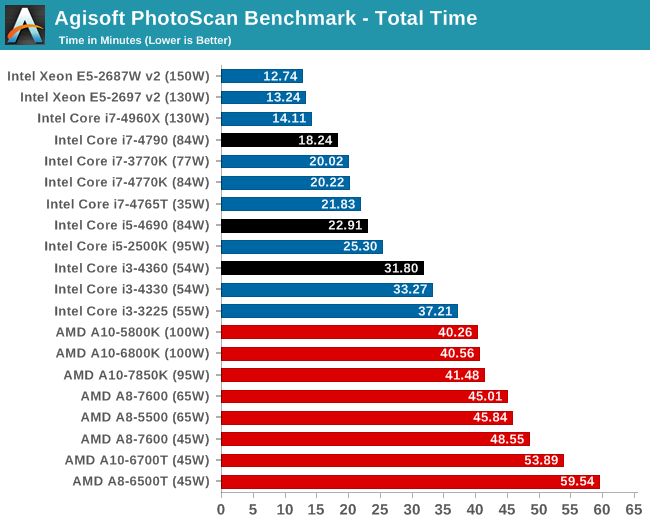
For Photoscan we see the incremental speedup with the i3 models, but the increased single thread speed of the i7 makes more of a difference.
Compression – WinRAR 5.0.1: link
Our WinRAR test from 2013 is updated to the latest version of WinRAR at the start of 2014. We compress a set of 2867 files across 320 folders totaling 1.52 GB in size – 95% of these files are small typical website files, and the rest (90% of the size) are small 30 second 720p videos.
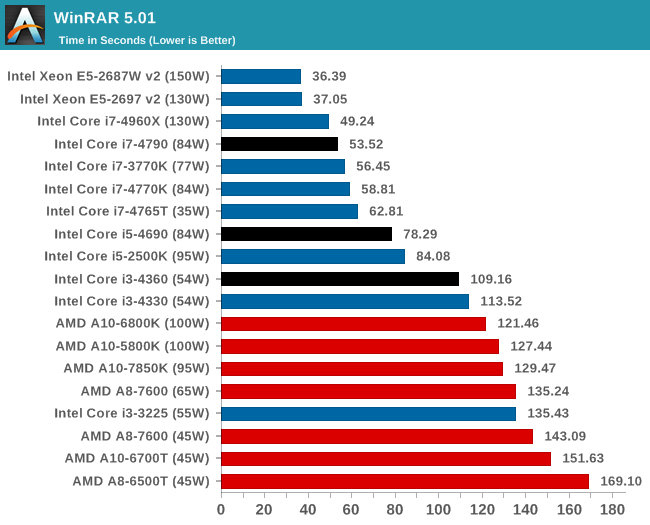
For WinRAR, the increase in the threads makes the most difference here, moving from i5-4690 to i7-4675T.
Image Manipulation – FastStone Image Viewer 4.9: link
Similarly to WinRAR, the FastStone test us updated for 2014 to the latest version. FastStone is the program I use to perform quick or bulk actions on images, such as resizing, adjusting for color and cropping. In our test we take a series of 170 images in various sizes and formats and convert them all into 640x480 .gif files, maintaining the aspect ratio. FastStone does not use multithreading for this test, and thus single threaded performance is often the winner.
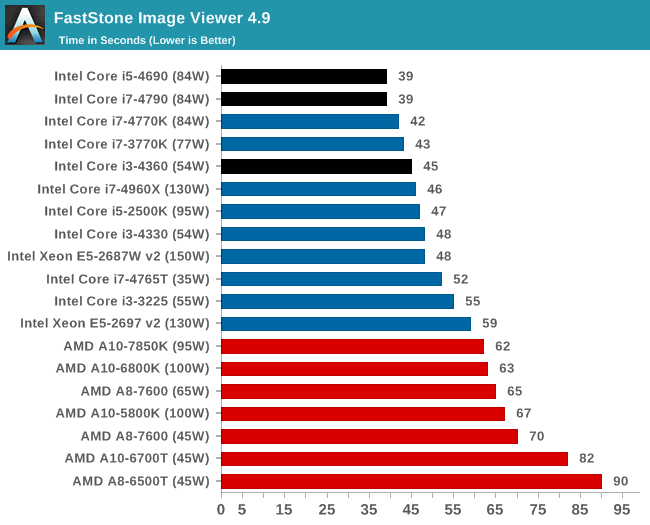
FastStone is all about the single thread speed.
Video Conversion – Xilisoft Video Converter 7: link
The XVC test I normally do is updated to the full version of the software, and this time a different test as well. Here we take two different videos: a double UHD (3840x4320) clip of 10 minutes and a 640x266 DVD rip of a 2h20 film and convert both to iPod suitable formats. The reasoning here is simple – when frames are small enough to fit into memory, the algorithm has more chance to apply work between threads and process the video quicker. Results shown are in seconds and time taken to encode.
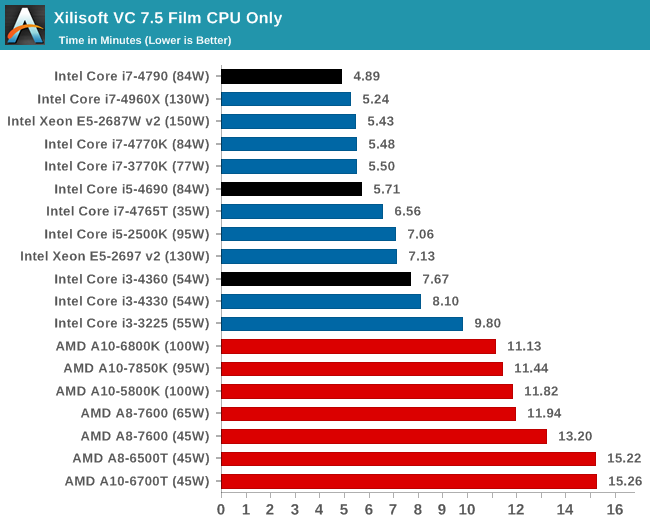
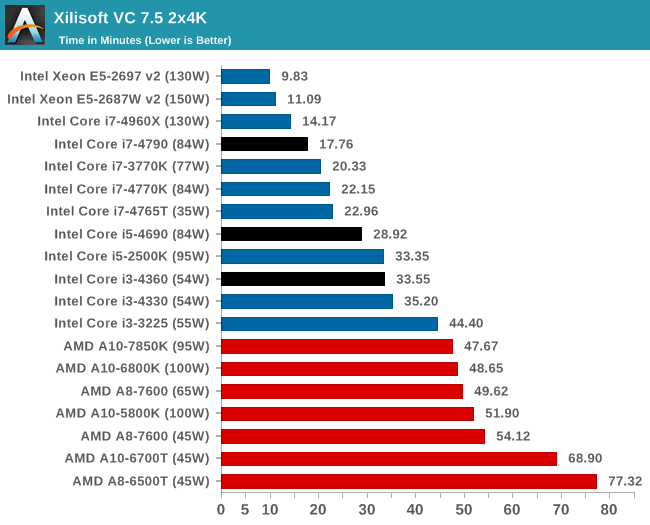
Small frames prefer more single thread MHz, whereas the dual 4K frame conversion prefers threads.
Video Conversion – Handbrake v0.9.9: link
Handbrake is a media conversion tool that was initially designed to help DVD ISOs and Video CDs into more common video formats. The principle today is still the same, primarily as an output for H.264 + AAC/MP3 audio within an MKV container. In our test we use the same videos as in the Xilisoft test, and results are given in frames per second.
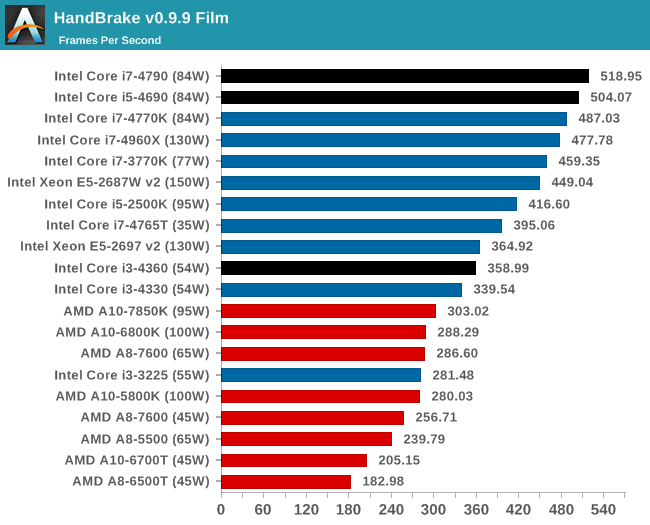
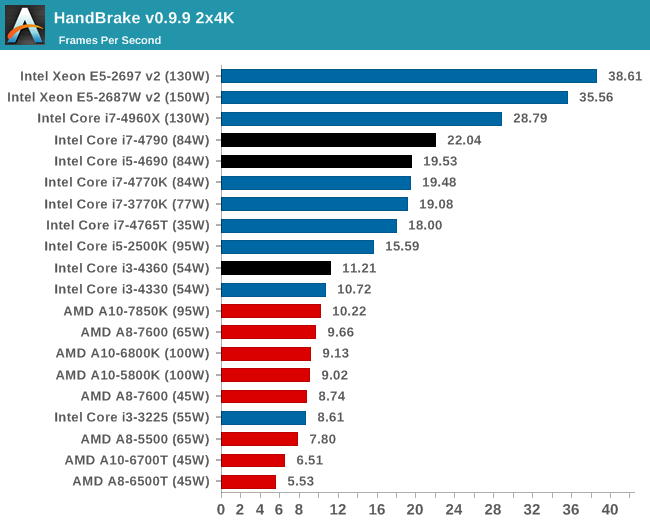
With Handbrake it would seem that it prefers actual cores rather than hyperthreading, given by the i5 and i7 being relatively close and 2x the i3.










130 Comments
View All Comments
rajod1 - Friday, May 30, 2014 - link
Well said, yes I agree many gamers or OCing people have sort of a sickness. They are addicted to hardware. They can't help it, like a moth to a flame. They will deny it but its true.klmccaughey - Sunday, May 11, 2014 - link
Ian, I am still confused by your description of SATA express/M.2/PCIe based SATA. Any chance of an article or comment on this? I am lost as to what to buy as I don't know now what fits what. I thought SATA express was PCIe SATA? I don't want to buy the wrong board or SSD.Galatian - Sunday, May 11, 2014 - link
M.2 is simply just a different connector type of SATA Express designed for Notebooks and SFF builts. Intel only states M.2 support on the 97 chipset, but it looks like most motherboard manufactures are releasing boards with SATA Express connectors as well.When you shop for a new SSD (and there is really isn't anything on the consumer market right now) you need to look at what your motherboard has: does it have an M.2 connector, SATA Express or both? Then buy accordingly, while minding that M.2 SSDs come in different physical sizes and you need to check if the fit into the slot. Drives using the "normal" SATA Express connector will probably come in the standard 2,5" format.
Also note that - as Ian stated - the current M.2 and SATA Express implementation is already pretty much outdated since all (except ASRock on the Extreme 6 series) motherboards only expose 2 PCIe 2.0 lanes, which limits the bandwidth to 10 Gbit/s. The Samsung XD941 M.2 for example is already bandwidth constrained on that setup.
On that note you might also want to check how the SSD is talked to. For example the Samsung XD941 still uses the AHCI protocol. SATA Express is capable of NVMe and there is no consumer SSD out yet with support for that.
Laststop311 - Monday, May 12, 2014 - link
It's going to be awhile before we reach the limit. The fastest sata express implementation is pcie 3.0 x4 giving almost 32gbit/sec bandwidth + NVMe needs implemented. Then it will be maxed until pci-e 4.0 is out and it's updated for that. And the cycle continues infinitely....klmccaughey - Monday, May 12, 2014 - link
Fuck it - that's far too complicated. I am just going to wait until broadwell when they can agree on a standard. This is like betamax all over again.kwrzesien - Monday, May 12, 2014 - link
+1, I think you've nailed it on the head. I don't every see myself buying or recommending a SATA Express drive - the connector is dog. M.2 has potential but can't they even come up with a size standard? I mean hello, something like t-shirts? S, M, L? The things could be any length an who knows what each board will support.kwrzesien - Thursday, May 15, 2014 - link
Further research down the rabbit hole: http://en.wikipedia.org/wiki/M.2After learning all about M.2 and seeing what is listed on NewEgg for the drives and motherboards I think we are in for a rough ride, nobody is listing all the the features that you need to decide whether two parts are compatible:
1) There are different keys in the connectors in both the cards and slot (B, M primarily but A through M are options). Both B and M support SATA, while B is also used for PCIe x2 and M is used for PCIe x4.
2. The cards are different lengths but these are standardized into 16, 26, 30, 38, 42, 60, 80 and 110 mm possibilities, with current Z97 desktop motherboards commonly supporting 42, 60 and 80. 80 seems to be the best option for fast and large SSDs, 42 will be mostly for tablets and ultrabooks.
3. There are different width standards 12, 16, 22 and 30 mm but so far everything seems to be 22 mm.
You would then call a 22x80 card a 2280.
4. There are different thickness standards, either single-sided or double-sided of 1.20, 1.35 or 1.50 mm. The connector on the board must support the proper thickness and SS or DS. Codes are S1-3 and D1-5 for single and double-sided at different thicknesses.
A 22x80 double-sided 1.35 thick card with an M key would be called 2280-D2-M.
5. SSD cards can use the SATA interface or SATA Express/NVMe (direct PCIe connection, less overhead). Currently all cards (Intel 530, Micron 550) seem to be SATA. Performance should be similar to SATA 6Gbps 2.5" drives so this form factor is really about convenience at this point not performance.
6. On the specs page at Newegg for the ASUS Maximus VII Gene Z97 (http://www.newegg.com/Product/Product.aspx?Item=N8... board you get this for M.2: 1 x M.2 Socket 3 with M Key. Looking at the physical board layout it supports 2260 and 2280 size cards and includes one fastening screw that can be moved to either position. I don't know how the "Socket 3" translates into single-side and double-side thickness codes.
7. On the specs page for the Micron M550 512GB M.2 SSD (http://www.newegg.com/Product/Product.aspx?Item=N8... you get Form Factor: M.2 Type 2280 and Interface: SATA 6Gb/s.
Now it is possible that the motherboard only supports SATA Express/NVMe devices on the M.2 slot while the Micron and other available SSD's are only SATA and may not work. Since the English version of the motherboard manual is not available yet it is hard to say.
Daniel Egger - Sunday, May 11, 2014 - link
Are you sure the Core i5-4460S doesn't have Turbo? Because all others and the predecessor do. Unfortunately Intel ARK doesn't list that one yet.bharatwd - Sunday, May 11, 2014 - link
Guys, when do you think the 4690K will release...Im planning to upgrade but i can wait a quarter as compared to the purchase of the 4690DanNeely - Sunday, May 11, 2014 - link
The most popular date in the internet rumor mill is Jun 2....